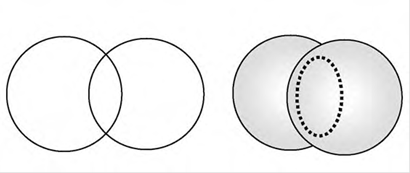


 الفيزياء الكلاسيكية
الفيزياء الكلاسيكية
 الكهربائية والمغناطيسية
الكهربائية والمغناطيسية
 علم البصريات
علم البصريات
 الفيزياء الحديثة
الفيزياء الحديثة
 النظرية النسبية
النظرية النسبية
 الفيزياء النووية
الفيزياء النووية
 فيزياء الحالة الصلبة
فيزياء الحالة الصلبة
 الليزر
الليزر
 علم الفلك
علم الفلك
 المجموعة الشمسية
المجموعة الشمسية
 الطاقة البديلة
الطاقة البديلة
 الفيزياء والعلوم الأخرى
الفيزياء والعلوم الأخرى
 مواضيع عامة في الفيزياء
مواضيع عامة في الفيزياء|
Read More
Date: 3-10-2016
Date: 29-10-2016
Date: 19-10-2016
|
Intersecting Spheres

If in 2-D we intersect two circles (called one-spheres by mathematicians), the intersection is either a point, two points, or a circle. In 3-D the intersection of two spheres (each called a two-sphere) will be either a point, a circle, or a sphere. What can the intersection of two three-spheres be? And three three-spheres?
Answer
Two identical three-spheres can intersect in a point, a circle, a sphere (two sphere), and a three-sphere. Now bring in a third identical three-sphere to intersect with the former two in appropriate combinations of points, circles, spheres, and a three-sphere, the latter when all three are coincident. With three intersecting identical three-spheres, a resulting single two sphere can be obtained only when the three three-spheres form a symmetrical configuration. If the leptons and quarks of the Standard Model of particle physics are physical manifestations of the finite rotational symmetries of the 3-D Platonic solids and their 4-D analogs as proposed in a model by F. Potter (see the reference below), then the intersections of three-spheres will become important in fundamental physics. A quark would be defined in a 4-D space, and its mathematical behavior would depend on the properties of three-spheres. The proton, for example, is a real particle composed of three quarks in our 3-D world that is, three 4-D entities according to the proposed model. So three three-spheres (representing the quarks) must intersect to form a two-sphere that “lives” in our 3-D space.



|
|
|
|
التوتر والسرطان.. علماء يحذرون من "صلة خطيرة"
|
|
|
|
|
|
|
مرآة السيارة: مدى دقة عكسها للصورة الصحيحة
|
|
|
|
|
|
|
عقد جلسة حوارية عن ضحايا جرائم التطرف ضمن فعاليات اليوم الثاني لمؤتمر ذاكرة الألم
|
|
|